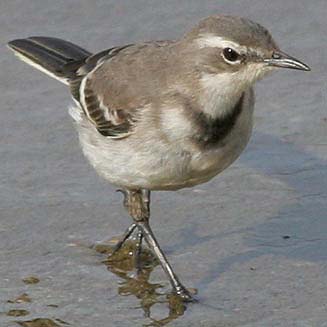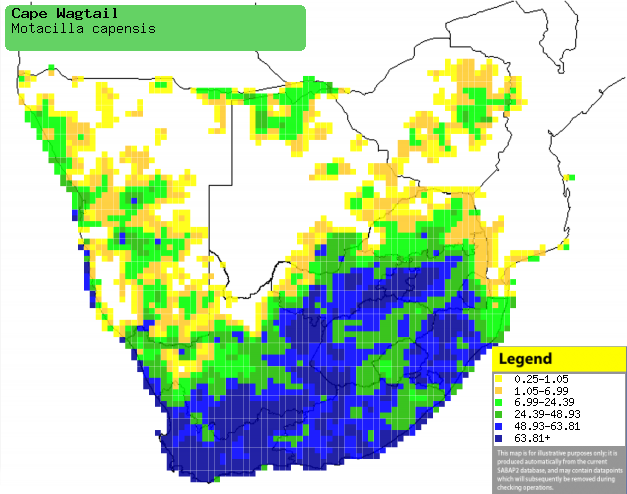|
Motacilla capensis (Cape wagtail)
Gewone kwikkie [Afrikaans]; Umcelu, Umvemve,
Umventshana (generic terms for wagtail) [Xhosa]; umVemve (generic term for
wagtail) [Zulu]; Kamukombo (generic term for wagtails) [Kwangali]; Motjoli
(generic term for wagtails) [South Sotho]; Moletaaka [North Sotho];
Mandzedzerekundze, Matsherhani, N'wapesupesu [Tsonga]; Mokgôrônyane
[Tswana]; Kaapse kwikstaart [Dutch]; Bergeronnette du Cap [French];
Kapstelze [German]; Alvéola do Cabo [Portuguese]
Life
> Eukaryotes >
Opisthokonta
> Metazoa (animals) >
Bilateria >
Deuterostomia > Chordata >
Craniata > Vertebrata (vertebrates) > Gnathostomata (jawed
vertebrates) > Teleostomi (teleost fish) > Osteichthyes (bony fish) > Class:
Sarcopterygii (lobe-finned
fish) > Stegocephalia (terrestrial
vertebrates) > Tetrapoda
(four-legged vertebrates) > Reptiliomorpha > Amniota >
Reptilia (reptiles) >
Romeriida > Diapsida > Archosauromorpha > Archosauria >
Dinosauria
(dinosaurs) > Saurischia > Theropoda (bipedal predatory dinosaurs) >
Coelurosauria > Maniraptora > Aves
(birds) > Order: Passeriformes
> Family: Motacillidae > Genus:
Motacilla
 |
 |
|
Cape Wagtail at Kleinmond, Western Cape, South Africa
[photo
Duncan Robertson ©] |
Cape Wagtail, Milnerton Sewage Works, South Africa. [photo Trevor Hardaker ©] |
Distribution and habitat
Although it occupies Uganda, eastern DRC and Kenya, the
bulk of its population extends from southern DRC through Zambia and Angola to
southern Africa. Here it is especially common across South Africa, Swaziland and
Lesotho, while more scarce in Namibia, northern and south-eastern Botswana,
Zimbabwe and southern Mozambique. It can occur almost anywhere that has open
ground adjacent to water, also favouring the rocky coastline, farms, villages,
cultivated land, parks, gardens and urban centres.
|
 |
|
Distribution of Cape wagtail in southern Africa,
based on statistical smoothing of the records from first SA Bird Atlas
Project (©
Animal Demography unit, University of
Cape Town; smoothing by Birgit Erni and Francesca Little). Colours range
from dark blue (most common) through to yellow (least common).
See here for the latest distribution
from the SABAP2. |
Predators and parasites
It has been recorded as prey of the following animals:
Brood parasites
It has been recorded as host of the
following birds:
Food
It mainly eats invertebrates and scraps of human food,
doing most of its foraging on the ground or in shallow water, often eating
animals that are already dead. It also takes insects attracted to lights in the
early morning or caught in car radiators. The following food items have been recorded
in its diet:
- Animals
- invertebrates
- insects
- crustaceans
- Talorchestia (sandhoppers)
- Uca (fiddler crabs)
- snails
- ticks
- tadpoles
- small fish
- small chameleons (Chamaeleonidae)
- Human food
- raw meat
- suet
- bread
- cake
- cheese
- hard-boiled eggs
Breeding
- Monogamous, territorial solitary nester, with pairs staying together over
multiple breeding seasons. While breeding males often fiercely attack their
reflection in mirrors.
- The nest is built by sexes in about 2-10 days, consisting of a cup made
of a wide range of materials, including grass, weeds, roots, reeds, pine
needles, rags, seed pods and string, lined with hair, rootlets, wool and
feathers. It is typically placed in a recess in a steep bank, tree, bush or
commonly in a man-made site, such as a hole in a wall, pot plant or bridge.
- Egg-laying season is year-round, peaking from about July-December.
- It lays 1-5 eggs, which are incubated by both sexes for about 13-15
days.
- The chicks are fed by both parents, leaving the nest after about 14-18
days. They are still fed by the adults for another 20-25 days, becoming
fully independent up to about 44 days after fledging, rarely up to 60 days.
Threats
Not threatened, in fact it is viewed as a 'bird of cattle'
and 'bird of good fortune' by the Xhosa people, and is therefore afforded
protection.
References
-
Hockey PAR, Dean WRJ and Ryan PG 2005. Roberts
- Birds of southern Africa, VIIth ed. The Trustees of the John Voelcker
Bird Book Fund, Cape Town.
|
